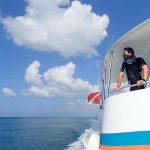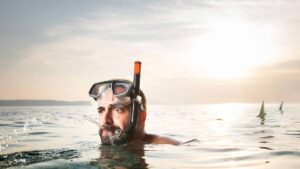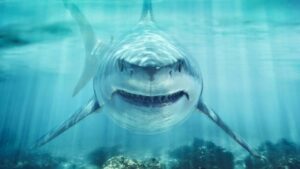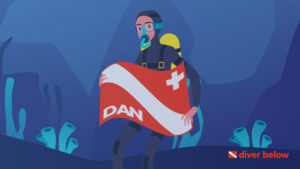Contents
EVOLUTION OF US NAVY DIVING
by Mark V. Lonsdale
SIGNIFICANT DATES IN NAVY DIVING (1823 – 2001)
Even though most of the following dates relate to US Navy diving, it would be remiss to omit the contributions of the early British inventors such as Augustus Siebe and Sir Robert Davis; eminent Scottish physiologist John Scott Haldane; the Royal Navy; and a French naval Lieutenant by the name of Cousteau.
Many of these dates have been drawn directly from early editions of the US Navy Diving Manual, while others were researched from a variety of diving related books and historical papers. (Note: In the interest of accuracy, if you wish to challenge any of these dates or events, I would like to hear from you – MV)
1828 Englishmen Charles & John Deane, based on earlier work in 1823 developing a “smoke helmet,” devise a similar helmet with a diving suit. However the suit was not attached to the helmet so a diver could not bend over or invert without risk of flooding the helmet and drowning. Never the less, the diving system is used in salvage work, including the successful removal of canon from the British warship HMS Royal George in 1834-35. This 108-gun fighting ship sank in 65 feet of water at Spithead anchorage in 1783.
1837 By attaching the Deane brothers helmet to a suit, Augustus Siebe developed the Siebe “Closed” Dress combination diving helmet and suit, considered the foundation of modern diving dress. This was a significant evolution from previous models of “open” dress that did not allow a diver to invert. (Siebe-Gorman went on to manufacture helmets continuously until 1975).
1837 Morse & Fletcher brass goods established in Boston, Mass.
1840 The British Navy orders the Siebe Closed Dress for work on the recovery of canon from the Royal George and subsequent blasting to clear the anchorage. The Admiralty hails the Siebe diving equipment as a significant improvement in diving equipment for the time. Subsequently, the “Siebe Improved Diving Dress” is adopted as the standard diving dress by the Royal Engineers.
1843 Based on lessons learned from the Royal George salvage, the first diving school is set-up by the Royal Navy
1844 A. Schrader’s Son Inc. diving equipment company founded in Brooklyn, NY
1864 Morse company name changes to Andrew J. Morse & Son.
1876 English merchant seaman, Henry Fleuss, develops the first workable, self- contained diving rig that uses compressed oxygen. This prototype of closed-circuit scuba utilizes rope soaked in caustic potash to absorb carbon dioxide so that the exhaled gas can be re-breathed.
1905 Several sources, including the 1991 US Navy Dive Manual (pg 1-8), state that the MK V Deep Sea Diving Dress was designed by the Bureau of Construction & Repair in 1905, but in reality, the 1905 Navy Handbook shows British Siebe- Gorman helmets in use. Since the earliest know MK V is dated 1916, these sources are probably referring to the earlier MK I, MK II, MK III & MK IV Morse and Schrader helmets.
1908 John Scott Haldane, Arthur E. Boycott and Guybon C. Damant, publish their landmark paper on decompression sickness. “The Prevention of Compressed-Air Illness” lays the foundation for staged decompression. Decompression tables based on this research are eventually adopted by the British Navy and later the United States Navy, saving many divers from the bends.
1912 Driven by Chief Gunner George Stillson, the navy sets up a program to test tables and staged decompression based on the work of Haldane.
1913 The Navy also begins developing the future MK V, influenced by Schrader and Morse designs.
1915 The submarine USS F-4 was salvaged from 304 feet establishing the practical limits for air diving. Three US Navy divers, Crilley, Loughman, and Nielson, reached 304 fsw using the MK V dress.
1916 With the addition of a battery-powered telephone, the design of the MK V was finalized – however, several more design improvements were made over the next two years.
1917 The Bureau of Construction & Repair introduces the MK V helmet and dress, which then becomes the standard for US Navy diving until the introduction of the MK 12 in the late seventies
1916/17 Based on lessons learned from the F-4 salvage, the Navy Dive School is established at Newport, Rhode Island (? – not yet confirmed)
1918 End of World War One (WW-I)
1924 The US Navy and Bureau of Mines jointly sponsor experimental dives using helium-oxygen mixtures.
1925 With the sinking and subsequent salvage of the submarine S-51, the navy discovers that they have only 20 divers qualified to dive deeper than 90 feet – a result of post- World War I cutbacks.
1927 Driven by a need for divers, the Navy School of Diving & Salvage (NSDS) was re- established at the Washington Navy Yard. (This was also known as the Navy Deep Sea Diving School and certificates from the fifties identify the Naval Gun Factory)
1927 To bring diving assets together, the Experimental Diving Unit (EDU) was brought to the Washington Navy Yard from Pittsburgh where they had been working with the Bureau of Mines.
1927 The weight of the MK V helmet and breastplate was reduced to 56 pounds with little change in the design there after.
1928 Invention of the Davis Submersible Decompression Chamber (SDC) diving bell
1929 Lieutenant C.B.”Swede” Momsen, a submariner and diver, develops and proves the escape lung that bears his name. It was given its first operational test when 26 officers and men successfully surfaced from an intentionally bottomed submarine.
1936 The Italian navy tests a diver controlled chariot torpedo system
1937 Lieutenant Commander Momsen heads up the experimental deep-sea diving unit at the Washington Navy Yard. NEDU presses a diver to 500 feet on helium mixed-gas.
1937 Diving Equipment & Salvage Company (now known as DESCO) was organized as a corporation in Wisconsin by divers Max Nohl & Jack Browne and doctor/hyperbaric physiologist Edgar End, MD.
1937 December – Max Nohl succeeds in diving to a depth of 420 feet in the cold waters of Lake Michigan, thereby breaking a depth record held by U.S. Navy diver Frank Crilley, since 1915. Nohl accomplished this feat using DESCO’s new diving equipment and breathing a heliox mixture prescribed by Dr. Edgar End.
1938 Edgar End and Max Nohl make the first intentional saturation dive, spending 27 hours at a depth of 101 feet in a Milwaukee hospital hyperbaric chamber. Decompression took five hours and one of the divers, Nohl , suffers the bends.
1939 The McCann-Erickson Rescue Chamber, actually developed by Momsen, is proven when the USS Squalus, carrying a crew of 59, sank in 243 fsw. Under the direction of Lieutenant Commander Swede Momsen, the rescue chamber made four trips and safely brought 33 men to the surface.
1939 Momsen’s divers, using both air and mixed-gas diving techniques recover the USS Squalus from 243 fsw. Based on this success, the Navy soon adopts a re-circulating MK V MOD 1 for mixed-gas diving. Helmet and breastplate weighed 103 pounds as opposed to the 56 pounds for the MK V MOD 0 air hat.
1940 Owen Churchill first produces swim fins. Initially less than a thousand pairs are sold, but in later years production increases substantially as thousands are sold to Allied forces.
1941-1944 (WW II) Italian naval divers, working out of midget submarines, make use of closed-circuit scuba to place explosives under British naval and merchant ships. Later in the war the British use this technology to sink the German battleship Tirpitz
1941 December 7, The Imperial Japanese forces bomb Pearl Harbor
1942 September – In addition to NSDS at Washington Navy Yard, the Naval Training School (Salvage) was established in New York. This was to take advantage of the training value in salvaging the Normandie, capsized at NY City’s Pier 88 as a result of fire-fighting efforts.
1942-43 In the Pearl Harbor salvage operations, navy divers spent about 16,000 hours under-water performing some 4,000 dives. Contract civilian divers contributed another 4,000 diving hours to the effort.
1942 In addition to Schrader and Morse, DESCO begins manufacturing the MK V for the US Navy and by 1945 was reported to be the largest diving equipment manufacturer in the world
1942-43 Lieutenant Jacques-Yves Cousteau and Emile Gagnan, an engineer for Air Liquide, redesign a car regulator that will automatically provide compressed air to a diver on demand.
1943 Bomb disposal experts and navy SeaBees team up to develop techniques to remove obstacles from enemy waters. Naval Combat Demolition Units, predecessors of the UDTs, are formed and serve at Normandy in 1944
1943 Cousteau, Frederic Dumas and Philippe Tailliez, make over 500 dives with the Aqua Lung, gradually increasing the depths on each dive. This is the first workable, open-circuit demand-type scuba regulator. In October Dumas reaches 210 feet in the Mediterranean Sea.
1946 Under new ownership, DESCO changes its name to Diving Equipment & Supply Company. Inc.
1946 Civilian diver Jack Browne, shareholder in Desco and inventor of the lightweight full-face mask that bears his name, makes a simulated dive to 550 feet in Desco’s pressurized wet pot.
1946 Naval Training School (Salvage) moved from New York to Bayonne, NJ.
1946 The British Admiralty Experimental Diving Unit was established
1947 Using Cousteau’s Aqua Lung, Frederic Dumas makes a record dive to 307 feet in the Mediterranean
1947 The Navy’s acquisition of Aqua-Lung equipment expanded the diving capabilities of UDT operations.
1948 A British Navy diver sets and open-sea record of 540 feet
1950-53 Underwater Demolition Teams (UDT) see action in the Korean conflict
1952 Development of the US Navy Emerson-Lambertsen closed-circuit oxygen rebreather
1954 Development of the prototype Mark VI semi-closed circuit mixed-gas rebreather for explosive ordnance disposal (introduced in 1963)
1955 Swede Momsen retires with the rank of Vice Admiral
1956 NEDU publishes the USN Standard Decompression Tables
1956 A Royal Navy diver reaches 600 feet in open sea on a helium-oxygen mix.
1957 The first episode of SEA HUNT airs, having a strong influence of many future deep- sea divers, the author included.
1957-62 Genesis Project experiments conducted as the pre-cursor of navy saturation diving
1958 USS Nautilus successfully passes under the North Pole
1960 January 23, Jacques Picard and Navy Lt. Don Walsh, in the US Navy-owned, Swiss-built bathyscaphe Trieste, descend to 35,820 fsw (10,916 msw, 6.78 miles). The dive is made in the Pacific’s Mariana Trench, 250 miles southwest of Guam.
1962 US Navy Seal Teams 1 and 2 formed
1962 With partial support of the US Navy, Swiss diver Hannes Keller reaches over 1000 feet off California.
1962 First practical saturation dive. September, Edward A. Link’s Man-in-the-Sea program had one man breathing helium-oxygen at 200 fsw for 24 hours in a specially designed diving system.
1963 April – USS Thresher sinks in 8,400 feet of water, beyond crush and recovery depths.
1964 Formation of the Deep Submergence Systems Project (DSSP)
1964 Sealab 1, under the direction of Captain George F. Bond, placed four men underwater for 11 days at an average depth of 193 fsw
1964 Navy adopts the MK 6 UBA semi-closed circuit rebreather for combat swimmers and EOD (maximum depth 200 fsw)
1965 Bob Kirby and Bev Morgan form Kirby-Morgan – later to produce the MK 1 and MK 21 for the navy.
1965 Sealab II puts three teams of ten men each in a habitat at 205 fsw. Each team spends 15 days at depth and one man, Astronaut Scott Carpenter, remains for 30 days
1966 Harbor Clearance Unit One (HCU-1) commissioned
1966 DESCO is purchased by Tom & Marilyn Fifield and moved to its current location at 240 North Milwaukee St., in Milwaukee.
1967 May 25, Swede Momsen loses his battle with cancer and will be missed by all. (The new NDSTC would later be dedicated in his honor).
1967 The first DDS & SDS-450 Deep Diving System was placed in Fleet Service by Harbor Clearance Unit One
1967-69 Kirby-Morgan manufactures the KMB-8 Bandmask
1967-71 SEAL Teams 1 & 2 deploy in Vietnam
1968 A record-breaking excursion dive to 1025 feet was made from a saturation depth of 825 feet at NEDU.
1968 The MK-2 Mod 0 Deep Diving System was developed and put aboard the Elk River (IX-501) to support Sealab III
1969 February – Sealab III ends in disaster with the death of diver Berry Cannon at over 600 fsw. He had been given a diving rig with no CO2 absorbent.
1970 The DDS MK-1 Deep Diving System comes into service. In October a world record open-sea dive was made to 850 feet.
1972 The DDS MK-2 MOD 0 sets the in-water record of 1,010 fsw
1972 First Deep Submergence Rescue Vehicle (DSRV) becomes operational
1973 ASR- 21 Pigeon & ASR-22 Ortolan commissioned and equipped as a DSRV, submarine rescue and saturation diving support platforms.
1975 NEDU is moved to Panama City to co-locate with Ocean Simulation Facility (1972)
1975 Divers using the MK 1 Deep Dive System descended to 1,148 fsw.
1976 Based on the Kirby-Morgan KMB-10 Bandmask, the U.S. Navy approves the MK-1 MOD 0 Light-weight, Mixed-Gas Diving Outfit for dives to 300 fsw on helium-oxygen
1976 The Kirby-Morgan SuperLite-17B goes into production and the KMB-10 is upgraded as the DSI Heli-Ox 18.
1977 The MK 1 Deep Diving System goes out of service
1978/79 NEDU develops the Mark 11 semi-closed system and the Mark 14 “push/pull system” for use in conjunction with an umbilical to a Personnel Transfer Capsule PTC to extend saturation dive times.
1979 The MK 15 mixed-gas closed-circuit rebreather replaces the MK 6 UBA
1979 Divers from NEDU complete a 37-day, 1,800 fsw dive in its Ocean Simulation Facility
1980 The new Naval Diving & Salvage Training Center (NDSTC) is completed on the Coastal System Station reservation in Panama City, Florida 1980 After extensive development, MK 12 Surface-Supplied Diving System (SSDS) replaces the MK V MOD 1 mixed-gas heavy gear
1981 A record 2,250-foot dive is made in the Duke Medical Center chamber
1981 The deepest salvage operation made with divers was 803 fsw when British divers retrieved 431 gold ingots from the wreck of HMS Edinburgh, sunk during World War II
1982 The Draeger LAR V (now designated the MK-25) closed-circuit oxygen rebreather replaces the MK 6 Emerson-Lambertsen rebreather for combat swimmers.
1982 The first Dry Deck Shelter (DDS) for the Swimmer Delivery Vehicles (SDVs) is completed by the Electric Boat Division of General Dynamics Corporation
1983 Navy SEALs deployed in Grenada, “Operation Urgent Fury”
1985 The MK 12 is officially approved for Fleet use to replace the MK V heavy gear
1985 New low magnetic MK 16 is approved for EOD
1989 Navy SEALs deployed in Panama, “Operation Just Cause”
1990 The MK-1 MOD 0 bandmask is replaced by the MK 21 MOD 1 demand helmet
1990-91 Navy SEALs deployed in “Operation Desert Storm”
1993 December – The MK 21 Superlite-style diving helmet replaces the MK 12
1994 Driven by the high cost of helium, in a joint effort, Kirby-Morgan and Divex develop the Divex UltraJewel 601 gas-reclaim system.
1997 Navy diving and salvage assets are used in the recovery of TWA 800
2000 MDSU2 recovers part of the Civil War ironclad “Monitor”
2000 Navy tests ASDS Advanced Swimmer Delivery System dry sub off of Hawaii
2001 The navy utilizes a saturation diving system for use on the Monitor project
(Note: In doing historical research, one often finds discrepancies in names, dates and places, for after all, history is often derived from the scrawled notes and recollections of someone’s yeoman or secretary, and often written long after the event. If the reader should find errors in this time-line, please contact the author directly so these can be researched, validated and adjusted – [email protected])
copyright Mark Lonsdale. All rights reserved




